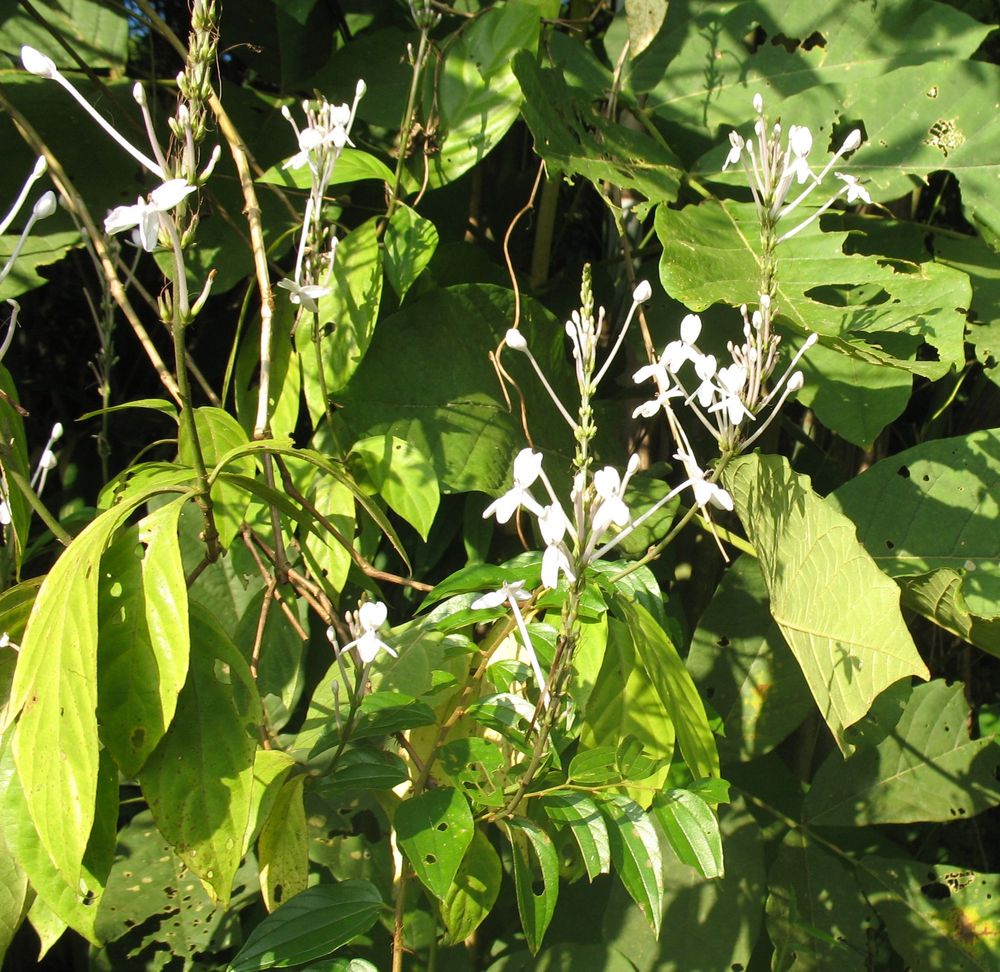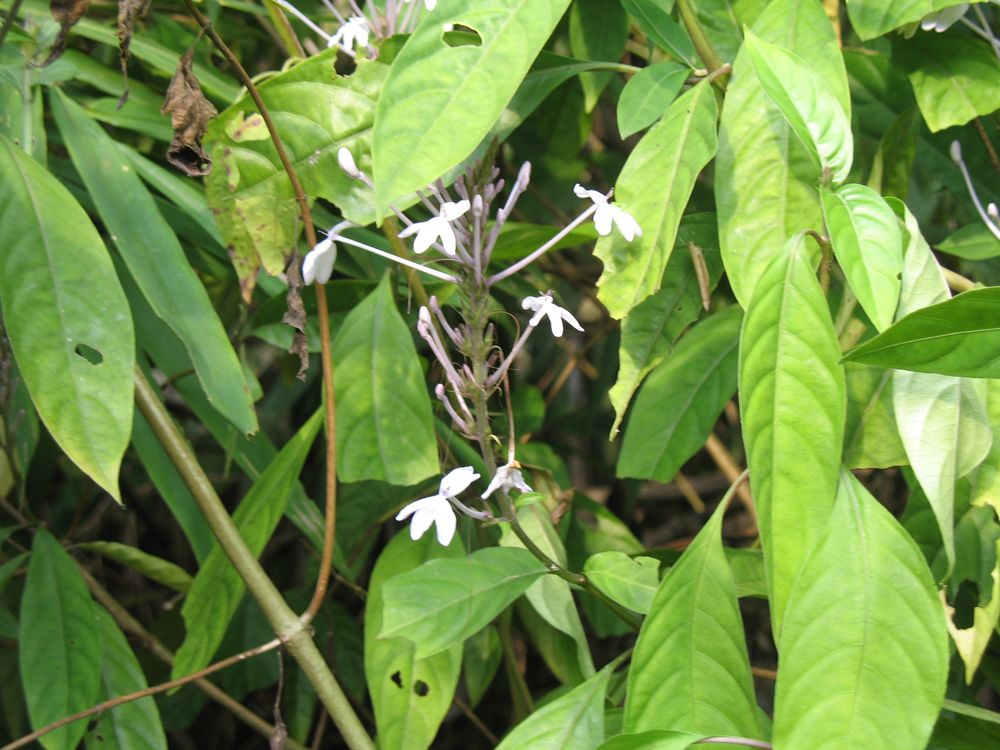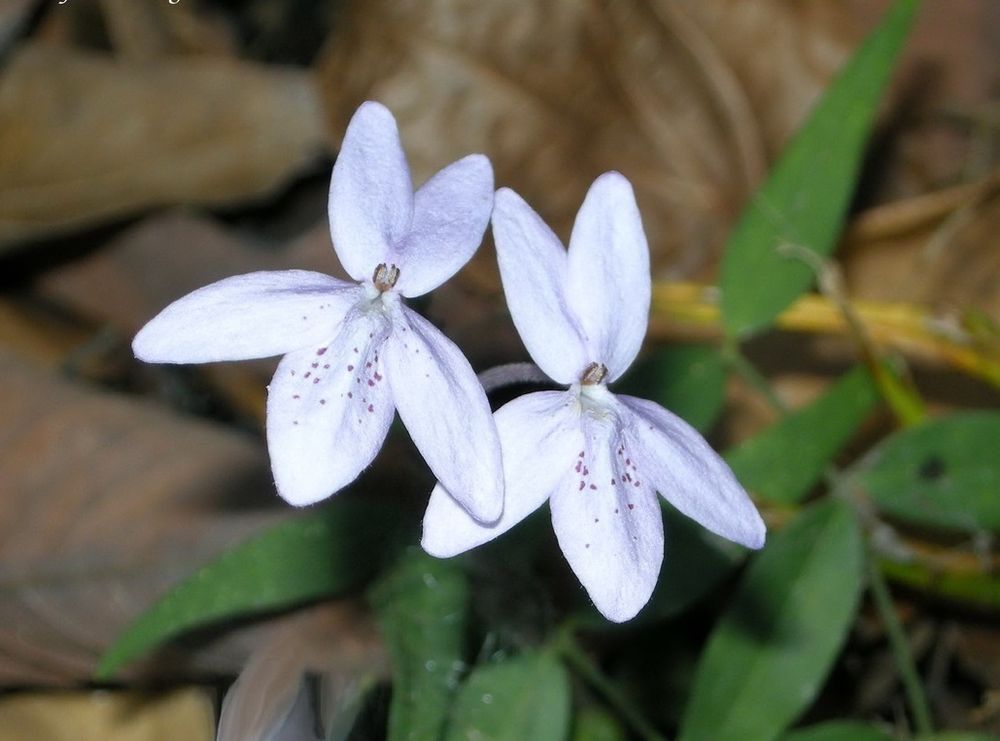Among the very numerous undergrowth plants that one encounters in Laos while walking in the forest are many Acanthaceae that we have already spoken about; this time we will say a few words about the genus Pseuderanthemum. Those who follow our chronicles will notice the resemblance with the genus Eranthemum found in Laos in the same habitat, but this one is a “pseudo”.
The genus Pseuderanthemum includes 170 species, all tropical, but the status of at least half of which has not yet been justified. In Laos, 5 or 6 species have been listed, including Pseuderanthemum crenulatum.
It is a small shrub of 2 to 3 meters with cylindrical stems that are more or less pubescent. Its leaves are elliptical, elongated, soft and hanging; they are arranged in a spiral around the stem. The inflorescence is a cluster of several pink or mauve flowers; the corolla opens at the end of a long tube on 5 irregular petals, the lower one of which is spotted with pink and yellow. The fruit is an ovoid capsule containing 4 seeds. The Lao call this plant pik kai dam, meaning “black chicken feather” and the Thai niao ma which probably means “dog pee”. The roots of this wild flower are taken in decoction to fight fever.
A related species, Pseuderanthemum latifolium, is a smaller shrub with stiffer oval leaves. The flowers are pink, blue, purple or white; they also have a long corolla tube and 5 irregular lobes. The Lao call it sa hom, which would mean “false indigo”; This translation is justified by the fact that one of the plants that provides indigo in Laos is also an Acanthaceae with blue-mauve flowers and that, in addition, a related species, Pseuderanthemum andersonii is used by the Akha to obtain a black or dark blue color. This sa hom is more used than the previous one in traditional medicine; the whole plant is used to relieve sprains, dislocations and rheumatism. Among the Hmong, where it is called ncaim toj liab, it is considered a contraceptive, a decoction of the roots is drunk during the period favorable to fertilization. Among the Vietnamese, who also consider that the plant is native to their country, it is known under the name of hoan ngoc; It is grown and packaged from the root and leaves to produce a tea exported throughout the region as a medicinal plant with all the virtues: it is said to treat all digestive disorders, including ulcers and hemorrhoids, it is also said to be effective in cases of hypertension, cholesterol, and diabetes. Finally, note that we often see in gardens in Laos Pseuderanthemum carruthersii, originally from Polynesia and cultivated for its flowers which stand out all year round against variegated foliage of yellow and green.
Parmi les très nombreuses plantes de sous-bois que l’on rencontre au Laos en se promenant en forêt figurent de nombreuses Acanthacées dont nous avons déjà parlé; cette fois ci nous dirons quelques mots du genre Pseuderanthemum. Ceux qui suivent nos chroniques remarqueront la ressemblance avec le genre Eranthemum trouvé au Laos dans le même habitat, mais celui-ci est un « pseudo ».
Le genre Pseuderanthemum comporte 170 espèces, toutes tropicales, mais dont le statut d’au moins la moitié n’a pas été encore justifié. Au Laos on a répertorié 5 ou 6 espèces dont Pseuderanthemum crenulatum.
Il s’agit d’un petit arbuste de 2 à 3 mètres aux tiges cylindriques plus ou moins pubescentes. Ses feuilles sont elliptiques, allongées, molles et pendantes; elles sont disposées en spirale autour de la tige. L’inflorescence est une grappe de plusieurs fleurs roses ou mauves; la corolle s’ouvre au bout d’un long tube sur 5 pétales irréguliers dont l’inférieur est taché de rose et de jaune. Le fruit est une capsule ovoïde contenant 4 graines. Les lao nomment cette plante pik kai dam, c’est-à-dire « plume de poulet noir » et les Thaï niao ma qui signifie sans doute « pipi de chien ». Les racines de cette fleur sauvage sont prises en décoction pour lutter contre la fièvre.
Une espèce voisine, Pseuderanthemum latifolium, est un arbuste plus petit dont les feuilles plus rigides sont ovales. Les fleurs sont roses, bleues, violettes ou blanches; elles ont également un long tube corollaire et 5 lobes irréguliers. Les lao la nomment sa hom, ce qui voudrait dire « faux indigo »; cette traduction se justifie par le fait que l’une des plantes qui fournit l’indigo au Laos est également une Acanthacée aux fleurs bleues-mauves et que, en outre, une espèce voisine, Pseuderanthemum andersonii est employée par les Akha pour obtenir une couleur noire ou bleue foncé. Ce sa hom est plus utilisé que le précédent en médecine traditionnelle; la plante entière est employée pour soulager entorses, luxations et rhumatismes. Chez les Hmong où elle se nomme ncaim toj liab on la considère comme contraceptive, une décoction des racines est bue pendant la période propice à la fécondation. Chez Les Vietnamiens qui considèrent d’ailleurs que la plante est originaire de leur pays, elle est réputée sous le nom de hoan ngoc ; elle est cultivée et conditionnée à partir de la racine et des feuilles pour donner un thé exporté dans toute la région comme plante médicinale ayant toutes les vertus: elle soignerait tous les troubles digestifs, y compris ulcères et hémorroïdes, elle serait également efficace en cas d’hypertension, de cholestérol, de diabète. Notons enfin que l’on voit assez souvent dans les jardins au Laos Pseuderanthemum carruthersii, originaire de Polynésie et cultivé pour ses fleurs qui toute l’année se détache sur un feuillage panaché de jaune et vert.





Among the very numerous undergrowth plants that one encounters in Laos while walking in the forest are many Acanthaceae that we have already spoken about; this time we will say a few words about the genus Pseuderanthemum. Those who follow our chronicles will notice the resemblance with the genus Eranthemum found in Laos in the same habitat, but this one is a “pseudo”.
The genus Pseuderanthemum includes 170 species, all tropical, but the status of at least half of which has not yet been justified. In Laos, 5 or 6 species have been listed, including Pseuderanthemum crenulatum.
It is a small shrub of 2 to 3 meters with cylindrical stems that are more or less pubescent. Its leaves are elliptical, elongated, soft and hanging; they are arranged in a spiral around the stem. The inflorescence is a cluster of several pink or mauve flowers; the corolla opens at the end of a long tube on 5 irregular petals, the lower one of which is spotted with pink and yellow. The fruit is an ovoid capsule containing 4 seeds. The Lao call this plant pik kai dam, meaning “black chicken feather” and the Thai niao ma which probably means “dog pee”. The roots of this wild flower are taken in decoction to fight fever.
A related species, Pseuderanthemum latifolium, is a smaller shrub with stiffer oval leaves. The flowers are pink, blue, purple or white; they also have a long corolla tube and 5 irregular lobes. The Lao call it sa hom, which would mean “false indigo”; This translation is justified by the fact that one of the plants that provides indigo in Laos is also an Acanthaceae with blue-mauve flowers and that, in addition, a related species, Pseuderanthemum andersonii is used by the Akha to obtain a black or dark blue color. This sa hom is more used than the previous one in traditional medicine; the whole plant is used to relieve sprains, dislocations and rheumatism. Among the Hmong, where it is called ncaim toj liab, it is considered a contraceptive, a decoction of the roots is drunk during the period favorable to fertilization. Among the Vietnamese, who also consider that the plant is native to their country, it is known under the name of hoan ngoc; It is grown and packaged from the root and leaves to produce a tea exported throughout the region as a medicinal plant with all the virtues: it is said to treat all digestive disorders, including ulcers and hemorrhoids, it is also said to be effective in cases of hypertension, cholesterol, and diabetes. Finally, note that we often see in gardens in Laos Pseuderanthemum carruthersii, originally from Polynesia and cultivated for its flowers which stand out all year round against variegated foliage of yellow and green.
Parmi les très nombreuses plantes de sous-bois que l’on rencontre au Laos en se promenant en forêt figurent de nombreuses Acanthacées dont nous avons déjà parlé; cette fois ci nous dirons quelques mots du genre Pseuderanthemum. Ceux qui suivent nos chroniques remarqueront la ressemblance avec le genre Eranthemum trouvé au Laos dans le même habitat, mais celui-ci est un « pseudo ».
Le genre Pseuderanthemum comporte 170 espèces, toutes tropicales, mais dont le statut d’au moins la moitié n’a pas été encore justifié. Au Laos on a répertorié 5 ou 6 espèces dont Pseuderanthemum crenulatum.
Il s’agit d’un petit arbuste de 2 à 3 mètres aux tiges cylindriques plus ou moins pubescentes. Ses feuilles sont elliptiques, allongées, molles et pendantes; elles sont disposées en spirale autour de la tige. L’inflorescence est une grappe de plusieurs fleurs roses ou mauves; la corolle s’ouvre au bout d’un long tube sur 5 pétales irréguliers dont l’inférieur est taché de rose et de jaune. Le fruit est une capsule ovoïde contenant 4 graines. Les lao nomment cette plante pik kai dam, c’est-à-dire « plume de poulet noir » et les Thaï niao ma qui signifie sans doute « pipi de chien ». Les racines de cette fleur sauvage sont prises en décoction pour lutter contre la fièvre.
Une espèce voisine, Pseuderanthemum latifolium, est un arbuste plus petit dont les feuilles plus rigides sont ovales. Les fleurs sont roses, bleues, violettes ou blanches; elles ont également un long tube corollaire et 5 lobes irréguliers. Les lao la nomment sa hom, ce qui voudrait dire « faux indigo »; cette traduction se justifie par le fait que l’une des plantes qui fournit l’indigo au Laos est également une Acanthacée aux fleurs bleues-mauves et que, en outre, une espèce voisine, Pseuderanthemum andersonii est employée par les Akha pour obtenir une couleur noire ou bleue foncé. Ce sa hom est plus utilisé que le précédent en médecine traditionnelle; la plante entière est employée pour soulager entorses, luxations et rhumatismes. Chez les Hmong où elle se nomme ncaim toj liab on la considère comme contraceptive, une décoction des racines est bue pendant la période propice à la fécondation. Chez Les Vietnamiens qui considèrent d’ailleurs que la plante est originaire de leur pays, elle est réputée sous le nom de hoan ngoc ; elle est cultivée et conditionnée à partir de la racine et des feuilles pour donner un thé exporté dans toute la région comme plante médicinale ayant toutes les vertus: elle soignerait tous les troubles digestifs, y compris ulcères et hémorroïdes, elle serait également efficace en cas d’hypertension, de cholestérol, de diabète. Notons enfin que l’on voit assez souvent dans les jardins au Laos Pseuderanthemum carruthersii, originaire de Polynésie et cultivé pour ses fleurs qui toute l’année se détache sur un feuillage panaché de jaune et vert.










Among the very numerous undergrowth plants that one encounters in Laos while walking in the forest are many Acanthaceae that we have already spoken about; this time we will say a few words about the genus Pseuderanthemum. Those who follow our chronicles will notice the resemblance with the genus Eranthemum found in Laos in the same habitat, but this one is a “pseudo”.
The genus Pseuderanthemum includes 170 species, all tropical, but the status of at least half of which has not yet been justified. In Laos, 5 or 6 species have been listed, including Pseuderanthemum crenulatum.
It is a small shrub of 2 to 3 meters with cylindrical stems that are more or less pubescent. Its leaves are elliptical, elongated, soft and hanging; they are arranged in a spiral around the stem. The inflorescence is a cluster of several pink or mauve flowers; the corolla opens at the end of a long tube on 5 irregular petals, the lower one of which is spotted with pink and yellow. The fruit is an ovoid capsule containing 4 seeds. The Lao call this plant pik kai dam, meaning “black chicken feather” and the Thai niao ma which probably means “dog pee”. The roots of this wild flower are taken in decoction to fight fever.
A related species, Pseuderanthemum latifolium, is a smaller shrub with stiffer oval leaves. The flowers are pink, blue, purple or white; they also have a long corolla tube and 5 irregular lobes. The Lao call it sa hom, which would mean “false indigo”; This translation is justified by the fact that one of the plants that provides indigo in Laos is also an Acanthaceae with blue-mauve flowers and that, in addition, a related species, Pseuderanthemum andersonii is used by the Akha to obtain a black or dark blue color. This sa hom is more used than the previous one in traditional medicine; the whole plant is used to relieve sprains, dislocations and rheumatism. Among the Hmong, where it is called ncaim toj liab, it is considered a contraceptive, a decoction of the roots is drunk during the period favorable to fertilization. Among the Vietnamese, who also consider that the plant is native to their country, it is known under the name of hoan ngoc; It is grown and packaged from the root and leaves to produce a tea exported throughout the region as a medicinal plant with all the virtues: it is said to treat all digestive disorders, including ulcers and hemorrhoids, it is also said to be effective in cases of hypertension, cholesterol, and diabetes. Finally, note that we often see in gardens in Laos Pseuderanthemum carruthersii, originally from Polynesia and cultivated for its flowers which stand out all year round against variegated foliage of yellow and green.
Parmi les très nombreuses plantes de sous-bois que l’on rencontre au Laos en se promenant en forêt figurent de nombreuses Acanthacées dont nous avons déjà parlé; cette fois ci nous dirons quelques mots du genre Pseuderanthemum. Ceux qui suivent nos chroniques remarqueront la ressemblance avec le genre Eranthemum trouvé au Laos dans le même habitat, mais celui-ci est un « pseudo ».
Le genre Pseuderanthemum comporte 170 espèces, toutes tropicales, mais dont le statut d’au moins la moitié n’a pas été encore justifié. Au Laos on a répertorié 5 ou 6 espèces dont Pseuderanthemum crenulatum.
Il s’agit d’un petit arbuste de 2 à 3 mètres aux tiges cylindriques plus ou moins pubescentes. Ses feuilles sont elliptiques, allongées, molles et pendantes; elles sont disposées en spirale autour de la tige. L’inflorescence est une grappe de plusieurs fleurs roses ou mauves; la corolle s’ouvre au bout d’un long tube sur 5 pétales irréguliers dont l’inférieur est taché de rose et de jaune. Le fruit est une capsule ovoïde contenant 4 graines. Les lao nomment cette plante pik kai dam, c’est-à-dire « plume de poulet noir » et les Thaï niao ma qui signifie sans doute « pipi de chien ». Les racines de cette fleur sauvage sont prises en décoction pour lutter contre la fièvre.
Une espèce voisine, Pseuderanthemum latifolium, est un arbuste plus petit dont les feuilles plus rigides sont ovales. Les fleurs sont roses, bleues, violettes ou blanches; elles ont également un long tube corollaire et 5 lobes irréguliers. Les lao la nomment sa hom, ce qui voudrait dire « faux indigo »; cette traduction se justifie par le fait que l’une des plantes qui fournit l’indigo au Laos est également une Acanthacée aux fleurs bleues-mauves et que, en outre, une espèce voisine, Pseuderanthemum andersonii est employée par les Akha pour obtenir une couleur noire ou bleue foncé. Ce sa hom est plus utilisé que le précédent en médecine traditionnelle; la plante entière est employée pour soulager entorses, luxations et rhumatismes. Chez les Hmong où elle se nomme ncaim toj liab on la considère comme contraceptive, une décoction des racines est bue pendant la période propice à la fécondation. Chez Les Vietnamiens qui considèrent d’ailleurs que la plante est originaire de leur pays, elle est réputée sous le nom de hoan ngoc ; elle est cultivée et conditionnée à partir de la racine et des feuilles pour donner un thé exporté dans toute la région comme plante médicinale ayant toutes les vertus: elle soignerait tous les troubles digestifs, y compris ulcères et hémorroïdes, elle serait également efficace en cas d’hypertension, de cholestérol, de diabète. Notons enfin que l’on voit assez souvent dans les jardins au Laos Pseuderanthemum carruthersii, originaire de Polynésie et cultivé pour ses fleurs qui toute l’année se détache sur un feuillage panaché de jaune et vert.


